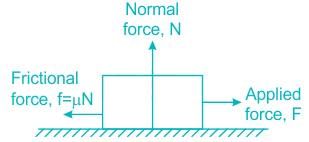Test: Introduction to Friction - Mechanical Engineering MCQ
10 Questions MCQ Test - Test: Introduction to Friction
A boy rolls a rubber ball on a wooden surface. The ball travels a short distance before coming to rest. To make the same ball travel longer distance before coming to rest, he may
In a large commercial complex there are four ways to reach the main road. One of the path has loose soil, the second is laid with polished marble, the third is laid with bricks and the fourth has gravel surface. It is raining heavily and Paheli wishes to reach the main road. The path on which she is least likely to slip is
To sharpen the blade of a knife by rubbing it against a surface, which of the following will be most suitable?
We slip while walking on a path having pond scum or green algae because:
Whenever the surfaces in contact tend to move or move with respect to each other, the force of friction comes into play
If no force is applied to a moving object, then it will stop due to ____.
A heavy iron block is placed on the ground, a person tries to push the block with the force of 200 N and the block does not move. This means
If the two rough surfaces are polished and put in contact, the friction force between them will __________.
Which of the following is contact force/forces?
I. Friction force
II. Magnetic force
III. Gravitation force





















